In the world of 3D printing, slicer software plays a pivotal role in transforming digital models into physical objects. But what exactly is slicer software and why is it so important? To put it simply, slicer software takes a 3D model and slices it into multiple layers, generating a set of instructions that tell the 3D printer how to build the object layer by layer. This process is essential for achieving accurate and high-quality prints.
Exploring the World of Free 3D Printer Slicer Software
While there are numerous slicer software options available, opting for free software can be an excellent starting point for enthusiasts and beginners. Free slicer software offers a multitude of benefits, including accessibility, being cost-effective, and community support. Let’s dive into some of the best free slicer software available.
Cura: Unleashing Beginner-Friendly Slicing Power
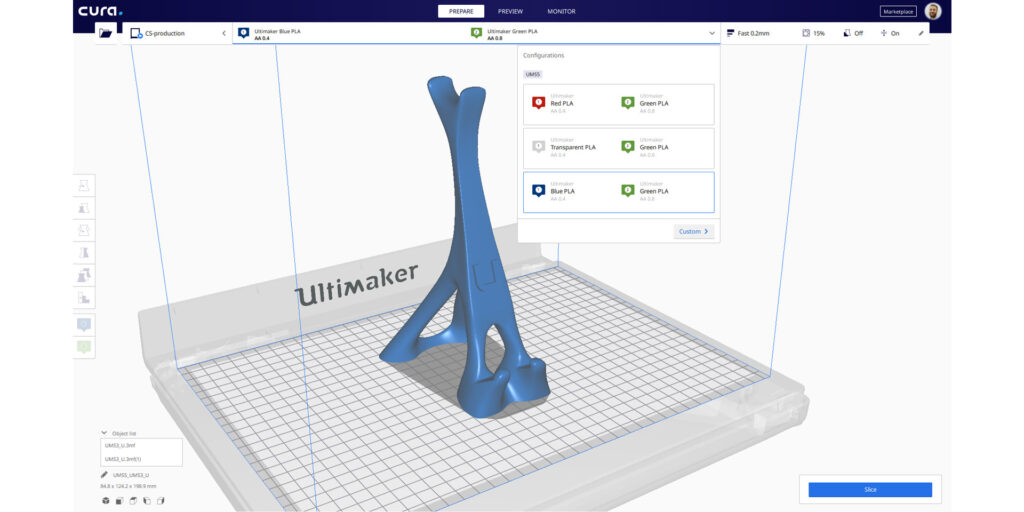
- User-friendly interface and intuitive workflow
- Extensive community support and resources
- Regular software updates and improvements
- Might not provide as many advanced features as some other premium slicers
- Resource-intensive and may require a powerful computer to run smoothly
Cura is a popular and versatile slicer software renowned for its user-friendly interface and powerful features. Developed by Ultimaker, Cura has gained widespread recognition and trust in the 3D printing community.
Features and functionality of Cura for seamless 3D printing
Cura offers a range of features to optimize 3D prints. It provides easy-to-use sliders and settings for adjusting print quality, infill density, support structures, and many other parameters. The software also includes a built-in 3D model viewer, allowing users to inspect their designs before slicing. Furthermore, Cura supports a wide array of 3D printer models, making it a versatile choice for many users.
Slic3r: Sculpting Your Prints with Precision
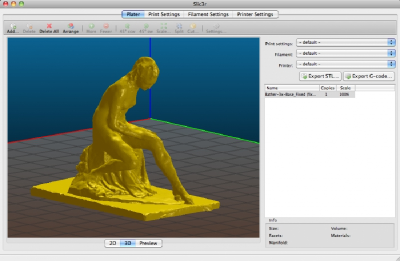
- Extensive customization options for advanced users
- Open-source software with a large community of developers and enthusiasts
- High degree of control over print settings
- Steeper learning curve compared to more beginner-oriented slicers
- Limited built-in model repair features compared to other slicers
Slic3r is an open-source slicer software that offers advanced features and customization options, making it a prime choice for enthusiasts and users seeking greater control over their prints.
Advanced features and customization options in Slic3r
Slic3r provides users with a wide range of settings to refine their prints. It allows for precise control over infill patterns, perimeter settings, cooling strategies, and even intricate options like sequential printing. This level of customization empowers users to fine-tune their prints to perfection, achieving precise geometries and superior print quality.
Best practices for achieving high-quality prints with Slic3r
To obtain the best results with Slic3r, consider the following recommendations:
- Calibrate Your Printer: Ensure that your printer is properly calibrated, including the extruder steps/mm, belt tension, and bed leveling. Accurate calibration will lay the foundation for successful prints.
- Optimize Support Structures: Experiment with Slic3r’s support options to find the optimal balance between ease of removal and support effectiveness. Adjusting support density and interface layers can lead to cleaner and smoother prints, especially for complex geometries.
- Gradually Increase Complexity: When working with intricate or complex designs, start with simpler models to establish the ideal settings before transitioning to more challenging prints. This iterative approach allows for better fine-tuning and avoids potential issues caused by overly ambitious projects.
PrusaSlicer: Revolutionizing Slicing for Prusa Printers
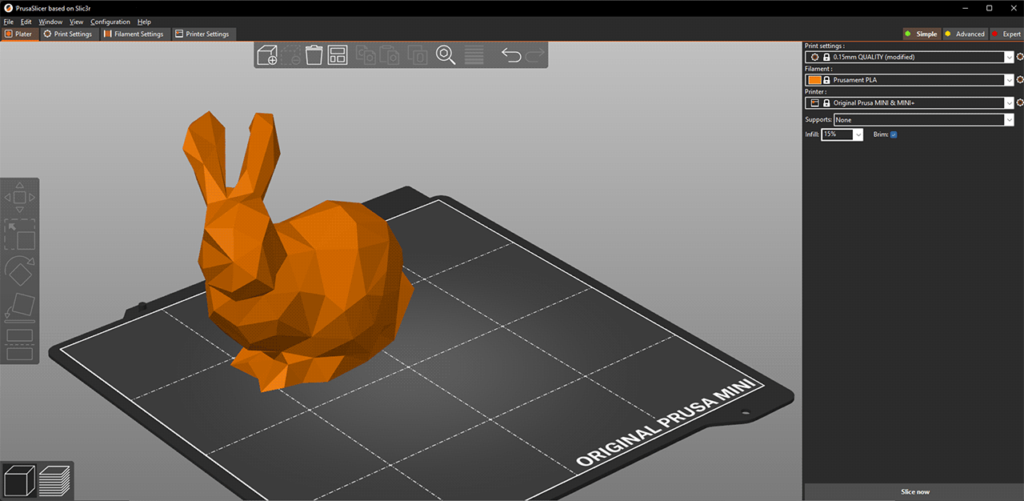
- Seamlessly integrated with Prusa printers, offering an optimized slicing experience
- Constantly updated and improved by the Prusa Research team
- Comprehensive customization options for advanced users
- Limited compatibility with printers other than Prusa models
- Beginners may find the abundance of settings overwhelming
PrusaSlicer is developed by Prusa Research specifically for their line of 3D printers, showcasing their dedication to providing a comprehensive slicing solution tailored to their hardware.
Unique features tailored for Prusa printers
PrusaSlicer is designed to leverage the full potential of Prusa 3D printers. It incorporates exclusive features such as automatic mesh bed leveling, custom support generation, and advanced firmware integration. These tailored features contribute to seamless and efficient slicing, ensuring optimal performance with Prusa printers.
Optimizing print settings with PrusaSlicer
To optimize your prints using PrusaSlicer, consider the following tips:
- Select the Appropriate Printing Profile: PrusaSlicer offers predefined printing profiles for different filament types and Prusa printer models. These profiles come with optimized settings, reducing the need for extensive tweaking. Selecting the appropriate profile will save time and improve print quality.
- Fine-Tune Support Settings: PrusaSlicer provides advanced support settings, allowing users to customize the support structures for their prints. Experiment with different options to find the right balance between support effectiveness and ease of removal.
- Explore Customizable Printer Settings: PrusaSlicer allows users to adjust various printer-specific settings. Take advantage of these customization options to optimize your printer’s performance for different materials and prints.
Simplify3D: Unleasing Professional-Grade Print Preparation

- Extensive customization and control over print settings
- Powerful tools for professionals and advanced users
- Accurate print time and material usage estimates
- Premium software with a one-time purchase fee
- Steeper learning curve compared to beginner-focused slicers
Simplify3D is a premium slicer software known for its extensive features and professional-grade capabilities. While it is a paid software, it offers powerful tools that are highly regarded in the industry.
Advanced capabilities for professional users
Simplify3D prides itself on providing advanced features that cater to the needs of professionals and enthusiasts. This software allows users to precisely control every aspect of their prints, including variable layer heights, different material configurations within a single print, and customized support structures. Simplify3D also provides highly accurate print time and material usage estimates, enabling users to plan and optimize their workflow effectively.
Tips for maximizing Simplify3D’s potential
Here are some tips to get the most out of Simplify3D:
- Leverage Variable Settings: Take advantage of Simplify3D’s variable settings feature, which enables different parameters to be applied to specific regions of a print. This can be useful for parts that require varying levels of strength or printing speed.
- Experiment with Custom Support Structures: Simplify3D allows users to customize their support structures extensively. By adjusting support density, interface layers, and support placement, users can achieve well-supported prints with minimal post-processing efforts.
- Utilize Multi-Material Printing: If you have a printer capable of multi-material printing, Simplify3D excels in managing complicated prints with different materials. Explore the software’s capabilities and experiment with various material combinations to unlock unique and complex designs.
IceSL: Empowering Creativity with Generative Design
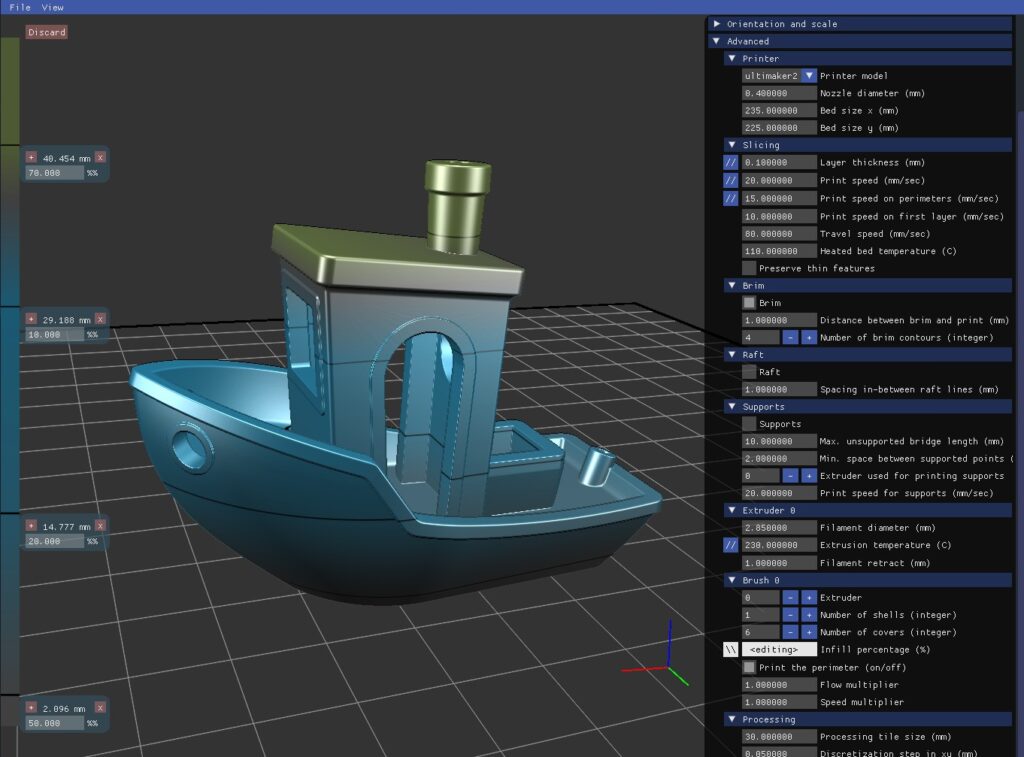
- Unique generative design capabilities
- Open-source software with a growing community of developers and artists
- Facilitates the creation of complex geometries with ease
- Limited compatibility with certain operating systems and hardware configurations
- Steep learning curve due to the advanced nature of generative design concepts
IceSL is a unique slicer software that combines the power of generative design algorithms with the flexibility of parametric modeling. This open-source software offers a range of creative possibilities, allowing users to generate complex 3D prints with ease.
Exploring the creative power of IceSL slicer software
IceSL stands out with its ability to generate complex shapes through generative design. Users can define parameters and constraints, and IceSL will automatically generate designs within those boundaries. This dynamic approach enables the creation of intricate geometries and structures that would be challenging or time-consuming to model manually.
Generating complex 3D prints using generative design
To harness the generative design capabilities of IceSL, follow these steps:
- Define Constraints: Specify the desired constraints, such as volume, connectivity, and thickness. These constraints will guide IceSL in generating suitable designs.
- Iterate and Experiment: IceSL provides various optimization algorithms and settings. Experiment with different combinations to explore a wide range of design possibilities. Iterate and fine-tune the parameters to achieve the desired outcome.
- Export and Print: Once satisfied with the generated design, export it as an STL file and slice it using IceSL’s built-in slicing capabilities. Transfer the resulting G-code to your 3D printer and bring your generatively designed object to life.
Showcase of IceSL’s capabilities with real-life examples
IceSL has been used to create stunning designs, including intricate vases, lattice structures, and artistic sculptures. Its generative design approach encourages creative exploration, enabling users to turn abstract concepts into tangible works of art.
CraftWare: Simplicity at its Finest
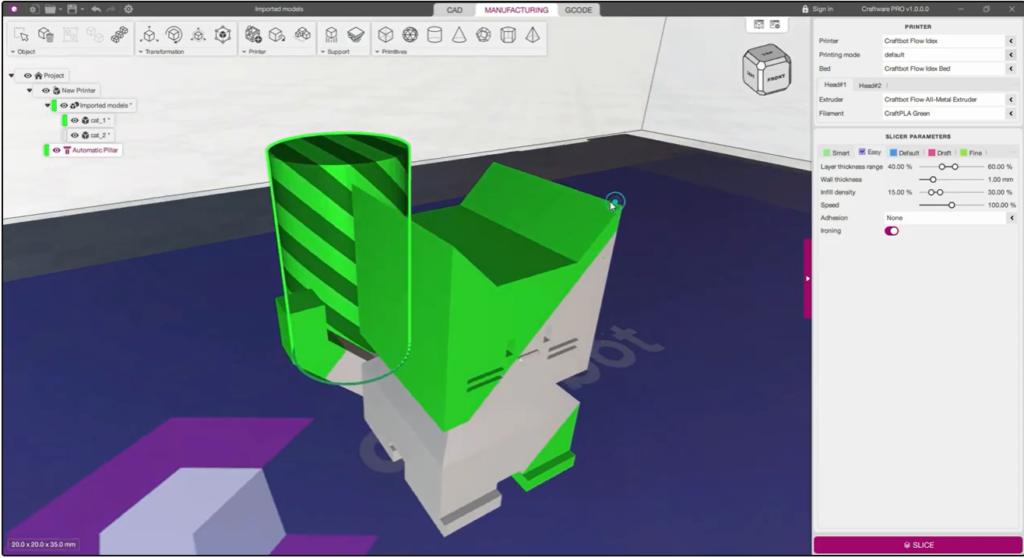
- User-friendly interface ideal for beginners and those seeking simplicity
- Predefined print profiles for commonly used printer models and filament types
- Efficient and straightforward slicing process
- Limited customization options compared to more advanced slicers
- Lacks some of the advanced features preferred by experienced users
CraftWare is a slicer software designed with simplicity in mind. It offers a user-friendly interface and streamlined features to make 3D printing accessible to beginners and users who prefer a straightforward slicing experience.
User-friendly interface and features for hassle-free slicing
CraftWare excels in providing a user-friendly experience with its intuitive interface. The software simplifies the slicing process by offering predefined profiles for different filament types and standard printer models. CraftWare also features a visualization tool that allows users to preview the sliced model layer by layer, ensuring an accurate representation of the final print.
Realizing stunning prints using CraftWare
To achieve stunning prints with CraftWare, consider the following guidelines:
- Explore Predefined Profiles: CraftWare comes with a variety of predefined print profiles suitable for different filament types and standard printer models. Select the appropriate profile that corresponds to your printer setup and filament choice to ensure a seamless printing experience.
- Fine-tune Print Settings: CraftWare provides basic print settings such as layer height, print speed, and infill density. While these options are limited compared to more advanced slicers, they still allow for customization to achieve satisfactory print quality.
- Preview the Sliced Model: Take advantage of CraftWare’s visualization tool to preview the sliced model layer by layer. This feature allows users to identify any potential issues or unexpected results before initiating the print.
Factors to consider when selecting a slicer software
- Compatibility: Check if the slicer software is compatible with your 3D printer’s hardware and firmware. Some software may have restrictions or limitations when it comes to certain printer models or file formats.
- User Interface: A user-friendly interface with intuitive navigation and clear labeling can streamline the slicing process. Look for software that provides a smooth and efficient workflow, making it easier for both beginners and experienced users to operate.
- Advanced Features: Consider the additional features offered by the slicer software. Some software provides advanced options for generating supports, adjusting print speeds, optimizing cooling strategies, and analyzing printability. These features can greatly enhance the user’s ability to fine-tune prints and achieve desired results.
- Community Support: Evaluate the level of community support available for the slicer software. Online forums, user communities, and active developer involvement can be valuable resources for troubleshooting, sharing tips, and getting assistance when needed.
Frequently Asked Questions
What is the best free slicer software for beginners?
In our opinion, Ultimaker Cura is a great choice for beginners. It offers an easy-to-use interface and a comprehensive set of features that are suitable for those just starting out in 3D printing. Additionally, Cura receives regular updates from its developers and has a large user community that can offer support and advice.
Which slicer software is most compatible with Ender 3?
Cura is widely recommended for use with the Ender 3 printer. It has multiple pre-configured profiles for various Creality printers, including the Ender 3. This makes setup and configuration easy, allowing users to start printing quickly with optimized settings.
Is Cura better than Slic3r?
Cura and Slic3r are both effective slicers, but their suitability depends on individual needs and preferences. For those looking for an easy-to-use slicer with a simple interface, Cura may be the better option. On the other hand, Slic3r’s highly customizable settings make it a better choice for experienced users wanting more control over their slicing process.
Can all slicers be used with any 3D printer?
While most slicers are designed to work with a range of 3D printers, compatibility may vary depending on the specific printer model and the slicer in question. It’s essential to consult the documentation of both the printer and the slicer software to ensure that they are compatible with one another. Some slicers may come with pre-configured profiles for specific printer models, making setup more straightforward.











